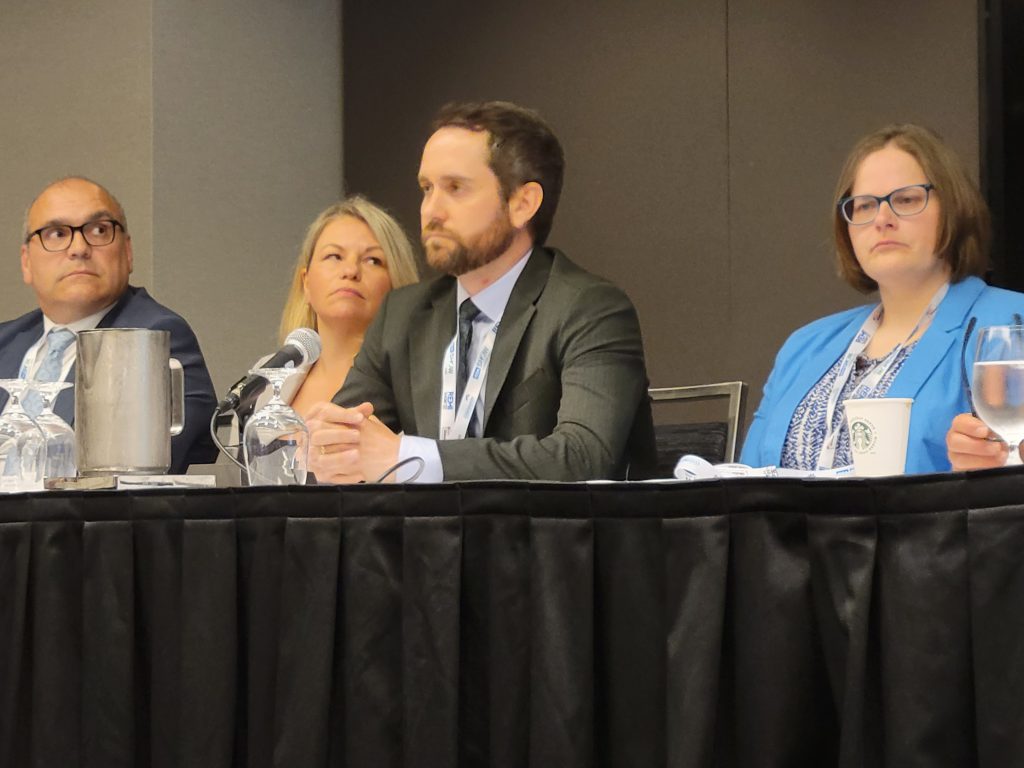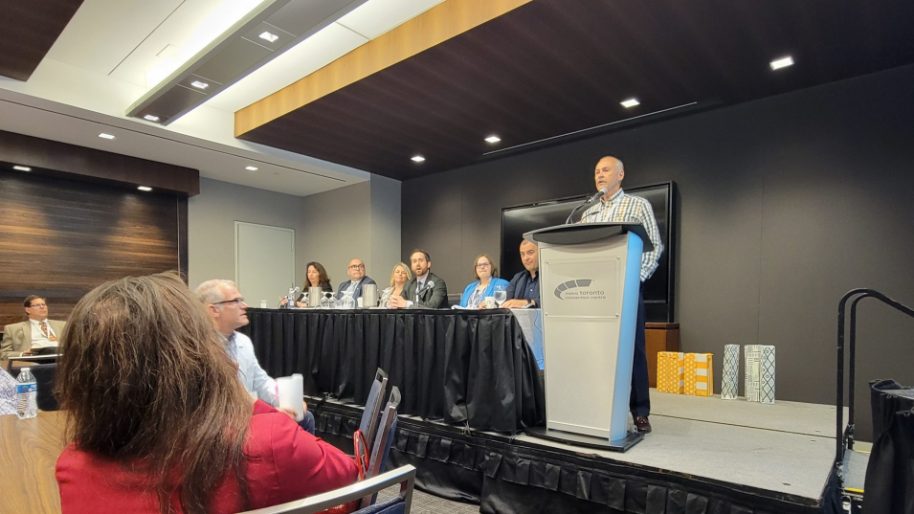Over the past two years, building service contractors (BSCs), frontline cleaners, and property management (PM) individuals have performed admirably and remarkably in difficult circumstances to keep facilities and the public safe.
Even with the worst of the pandemic behind us, though, BSCs, PMs, and the sanitation and real estate industries are facing major challenges moving forward. Whether it is hiring and retaining workers, increasing operational efficiencies, wages, inflation, education and training, or the balance between several of those factors, these are serious issues that must be spotlighted and addressed.
At the recent 2022 ISSA Show Canada in Toronto, a keynote panel made up of leaders in the BSC and PM industries delved into these issues and assessed the potential path forward.
Moderated by Phillippe Mack, Senior VP of Customer Service and US Expansion at Bee-Clean Maintenance, the panel consisted of John Castelhano, VP of Strategic Sourcing at BGIS; Elspeth Evans, Director of Office East at QuadReal Property Group; Kimberly Train, Director of Platform Services and Procurement at OMERS; Chris King, Senior VP at Hallmark Housekeeping Services Inc.; Roberta Polyak, VP of HR at Bee-Clean; and Tony Raposo, Regional VP of Operations at GDI Services Canada.
Technology’s ROI for cleaning
The discussion kicked off with a look at evolving technologies in the industry and how they can increase return on investment for PMs and BSCs.
Hallmark’s King noted that while technological development in the industry has historically been linear –a company or vendor’s new singular product is implemented by service providers for one particular task – now, automation allows for broader application and exponential gains and is redefining cleaning and scheduling.
Particular technologies to have grown in prominence in recent years include robots for floor cleaning and vacuuming, unprecedented automation and data collection, and sensory intelligence. Those shifts look set to dominate the landscape in the coming years.
Of particular interest to the panelists was IOT-based sensory tech. Utilizing these tools means PMs or cleaning managers and staff can know in real-time which areas of a facility are due for cleaning – for instance, washrooms that have seen high traffic in a day rather than those that have been barely used. In turn, this allows for dynamic scheduling and deployment of resources instead of static schedules that can end up wasting resources.
In short, sensory tech allows workers to concentrate their efforts where they are needed most.
BGIS’s Castelhano added that technology and automation are “absolutely critical” for the modern property manager or sanitation provider, and have their place and ROI from top to bottom, proving useful in everything from recruiting and training new employees to procuring products and services and improving and service delivery validation.
“On that last point, our clients want service validation, they have been repeatedly telling us that,” Castelhano said. “Tech solutions can certainly help with that, as well as increasing their efficiencies and pushing the boundaries of what they can do.”
Castelhano and Mack also both highlighted the role technology and automation can play in streamlining time management and payment processes, as well as quality control. “Moving from manual timekeeping processes to automated time and attendance platforms streamlines process, and the same could apply to manual quality control,” added Mack. “Think of the benefits of replacing manual inspections with real-time tablet-based QA platforms.”
OMERS’s Train also emphasized the role that technology can play in visibility and performance reporting.
“As a head-office person in PM, I have the luxury of robotics reports but not reports about the fulfillment of cleaning,” Train noted. “Our customers and contractors want that visibility. They – and we – want to ensure that high-priority tasks are fulfilled to the required quality.” The increasing adoption of automation and AI lends itself neatly to that demand by automatically logging and tracking tasks and performances.
GDI’s Raposo concluded that while there is still some work to do on the tech front – areas like chemical production, waste management, and carbon footprint reduction, he says, are often under-utilizing the solutions that can be available – the ROI on these new technologies is clear. “Set against the context of inflation and wage increases, automation can provide a significant boost to your bottom line by streamlining your operations. But we must ensure that we act on the intelligence we derive from technology.”
The panelists did have one warning for the industry: technology must be implemented smartly.
“We need to adapt robotics to meet the specific needs of sites,” Train told the audience. “Don’t try to do too much; the technology you implement needs to solve an actual problem or deficiency to be worth the investment.”

L-R: Raposo, Evans, King, Polyak
The labour concern – a balancing act
Meanwhile, the facility management and cleaning industries have been confronting a labour problem that has intensified since the depth of the pandemic.
The panelists were unanimous in identifying attracting workers as the foremost challenge faced by BSCs and PMs in mid-2022. Given that Canada’s decades-high rate of inflation does not look like falling back anytime soon, workers are expecting – and in many cases demanding – higher wages than the industry has typically offered.
“The applicant pool is shrinking, turnover is rising and quickening,” said King. “Some of the big factors in these challenges include the demand for workers and the need to balance wages against inflation. The industry still has some catching up to do. Money is the big allure.”
Bee-Clean’s HR VP Polyak noted it is not just wages that need addressing but the perception of the industry overall. “How do you attract employees and break the stigma and stereotypes that still, unfortunately, surround the cleaning industry?” she asked the panel and the audience.
Polyak called the dilemma ‘The Great Expectation’. “Workers want to know what you are going to do for them,” she added. “That’s a question that employers are increasingly needing to answer right off the bat.”
Asked what keeps them up at night these days, the panelists cited the balance between labour constraints and the need to protect the bottom line as a key dilemma – one which is likely to be familiar to anyone in the industry right now.
Similarly to Polyak, Train gave the problem a moniker: ‘The Great Squeeze’. “It becomes a question of what has to be reduced or eliminated in order to allow us to raise wages while also delivering what our customers demand,” she said. “Cutting or limiting costs but paying attractively and fairly is an exceptionally difficult line to walk.”
The panel session concluded that while technology and automation’s increased ROI can mitigate some of the effects of the labour crunch by reducing employees’ workload and allowing them to focus on specialized tasks without being spread too thin, it is a delicate balance and one that must take workers into account – don’t “techwash,” as Raposo put it.
“Technology is naturally concerning for employees as a potential threat to their livelihood,” advised Polyak. “Service providers like us need to show employees and contractors that it is a help, not a threat. Engage staff in discussions about technology and automation – seek their feedback.”
When it comes to employee attraction and retention, the best strategy is to pay them enough to get them on board – “meet them with money,” says Polyak – and then create a family culture wherein you take care of your employees and communicate.
“As well as the obvious bottom-line concerns, it’s all about the wellbeing of employees,” Polyak added. “The right culture, training, and recognition equate to a stickier relationship with associates, which displays opportunities for advancement and lowers turnover.”
Raposo echoed the declaration that cultivating a warm and welcoming culture is paramount to employee retention. “Your company’s beliefs and values will pass onto your employees if you are vocal and consistent with them.”
Collaboration is key
Doing all this, of course, is not easy. Paying competitive wages and providing the kind of support and flexibility that workers are looking for all while protecting your bottom line and maintaining efficiencies of performance is an almighty challenge.
Technology can certainly help, but the panel’s parting advice was on the importance of collaboration.
“It’s not just about how tech factors into our staffing model,” said QuadReal’s Evans. “It’s about how we can boost that staff retention and ensure that our cleaners are reflective of us as a company. How can we work with our janitorial provider to share a team feel and culture?”
Castelhano added that BSCs and PMs must be sure to invest in and focus on making all the administration and overhead processes as efficient as possible, as well as exploring new efficient methods to deliver training and education, to help offset costs. “That responsibility is not solely on BSCs and it’s not solely on PMs,” he stressed. “It has to be a joint effort.” That was echoed by Raposo, who noted that the pandemic has illuminated the need for a highly transparent and collaborative partnership.
“Client happiness, employee care, budget management – this is all a real balancing act,” concluded Polyak. “A new and heightened level of collaboration is required to create a win/win situation for all parties. Increased transparency at all levels is a must, and that’s the key to successful and lasting partnerships and helping to mitigate the unfortunate reality that the pandemic and inflation have imposed upon our industry.”





